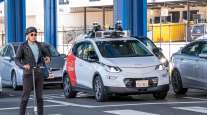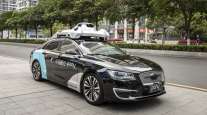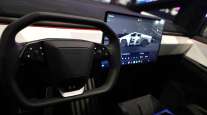Contributing Writer
Analysts: Trucking Ripe With Opportunities for Autonomous Technology

[Stay on top of transportation news: Get TTNews in your inbox.]
Many headlines about autonomous driving focus on the consumer auto market, but the commercial and heavy-duty truck segment are where self-driving technology will make its quickest penetration — and strongest business case — transport industry analysts and executives said.
“Trucking applications will be one of the first places where we will see this tech come to market,” said Chris Urmson, who led the Google self-driving car team and is now CEO of Aurora, a Palo Alto, Calif.-based self-driving technology company.
It’s a matter of economics, he said.

Urmson
Aurora is developing a fully autonomous system that works in passenger cars and trucks, but he noted that such systems could add tens of thousands of dollars to a vehicle’s cost.
“That’s not compelling for an individual’s car, but it is of interest for fleet operators because of the efficiencies that can be gained,” Urmson said. “There’s a business case.”
Truck manufacturers are exploring how self-driving semi-tractors could start working in commercial applications sooner than people expect, said Darren Gosbee, Navistar’s vice president of advanced engineering. In particular, companies are exploring both hub-to-hub and dock-to-dock operations.

Gosbee
“In hub-to-hub, a driver would set the vehicle up, connect the trailer, do an inspection and then get out. The truck would get on the on-ramp and then the highway and then the offramp and come to a stop. A driver would take it to the dock,” Gosbee said. Dock-to-dock is intended as fully autonomous transport.
Gosbee noted, however, that these types of freight-hauling would require significant constraints: depots adjacent to highway access with no or minimal cross traffic, and routes and lanes that are carefully mapped and consistent.
Some companies are exploring options. TuSimple, a San Diego startup, is running such routes with retrofitted International and Peterbilt tractors. UPS is a client.
Late last year, Plus.ai, a Cupertino, Calif., startup, completed a cross-country commercial run with an International truck that covered more than 2,800 interstate miles in autonomous mode.
“Solving autonomous driving requires exposure to all types of weather, road conditions and driving scenarios,” the company told Transport Topics. “That is why Plus.ai is focused on an extensive testing program that will cover all permissible continental states in the U.S. by the end of 2020.”
For now, all of these pilot programs use a safety driver to assume control if needed, but TuSimple plans to demonstrate fully driverless operations next year.

The industry is struggling to attract a new generation of technicians to maintain and repair increasingly high-tech trucks. Seth Clevenger spoke in Atlanta with Technology & Maintenance Council President Robert Braswell and Chairman Stacy Earnhardt to find out who's fixing the trucks of tomorrow. Hear a snippet, above, and get the full program by going to RoadSigns.TTNews.com.
Commercial vehicle builders and their technology partners are exploring how to deploy this so-called Level 4 of automated driving, labeled as such by SAE International, where the robotic system can control the vehicle under certain conditions without relying on a driver for fallback assistance.
Earlier this year, Volvo Trucks established its Volvo Autonomous Solutions division to focus on commercialization of self-driving trucks. Already, several projects are underway.
At the Brønnøy Kalk mine in Norway, autonomous Volvo FH trucks are transporting limestone along a 5-kilometer stretch. Elsewhere, Volvo is developing its Vera autonomous tractor to move containers from a logistics center in Gothenburg, Sweden, to a nearby port.
Volvo Trucks North America President Peter Voorhoeve said these types of projects can launch quickly at this stage of autonomous development because the applications occur in contained areas, with minimal traffic and no public vehicle access. Thus, there’s less of a safety risk.
That fits with the assessment of Michael Ramsey, senior research director at Gartner Inc.
Ramsey sees autonomous driving happening first in areas where there are specific conditions — tasks that are expensive, dangerous, on private or controlled property, or that are limited in complexity.
“Commercial trucking hits at least four of those boxes. That’s why it is a good area for autonomy work,” Ramsey said.

Ramsey
The biggest hurdle facing self-driving vehicles is technical complexity, he said. Factors such as cross traffic at intersections, bicycles, pedestrians and the limits of digital connectivity in certain areas all create challenges.
“The more decisions a robot has to make, the harder and more expensive it is,” Ramsey said.
Settings for controlled environments are more straightforward. Mining, for example, takes place in an area without traffic complexity — and where there is high risk for worker injuries.
“It is the perfect setting for an autonomous vehicle,” Ramsey said. “You are removing a human from a dangerous situation, and you are replacing someone who has a high wage. The return on investment is easy to understand.”
Still, there are skeptics.
While the industry is starting to grasp the idea for autonomous operations in contained areas, open-road use beyond pilot programs remains far away, said Andrej Divis, director of automotive, global heavy truck research at IHS Markit.
“It’s not around the corner,” Divis said, noting that deployment still requires regulatory changes, isolated lanes and autonomous truck hubs, he said.
“Our baseline scenario calls for annual sales of a few hundred units in the 2030s, and we are looking at pretty low numbers of SAE Level 4 and 5 autonomy among Class 4-8 trucks even out to 2040,” Divis said.
Want more news? Listen to today's daily briefing:




